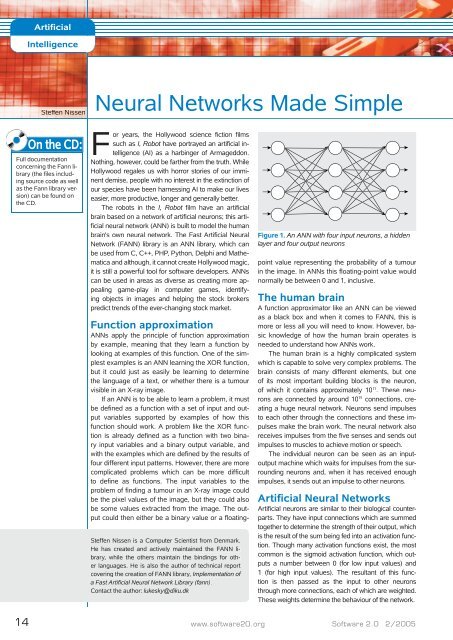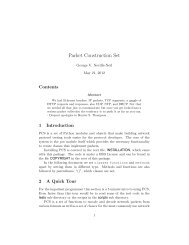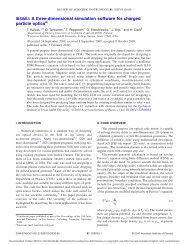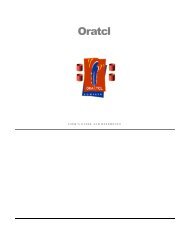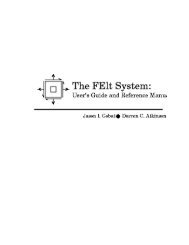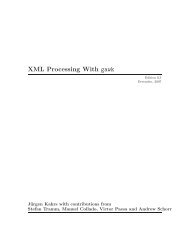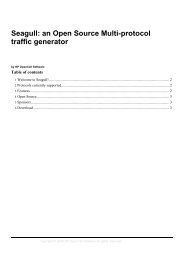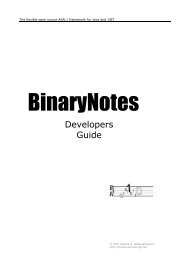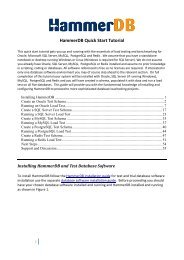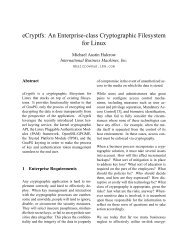Neural Networks Made Simple - Fast Artificial Neural Network Library
Neural Networks Made Simple - Fast Artificial Neural Network Library
Neural Networks Made Simple - Fast Artificial Neural Network Library
You also want an ePaper? Increase the reach of your titles
YUMPU automatically turns print PDFs into web optimized ePapers that Google loves.
<strong>Artificial</strong>IntelligenceSteffen Nissen<strong>Neural</strong> <strong><strong>Network</strong>s</strong> <strong>Made</strong> <strong>Simple</strong>On the CD:Full documentationconcerning the Fann library(the fi les includingsource code as wellas the Fann library version)can be found onthe CD.For years, the Hollywood science fiction filmssuch as I, Robothave portrayed an artificial intelligence(AI) as a harbinger of Armageddon.Nothing, however, could be farther from the truth. WhileHollywood regales us with horror stories of our imminentdemise, people with no interest in the extinction ofour species have been harnessing AI to make our liveseasier, more productive, longer and generally better.The robots in the I, Robotfilm have an artificialbrain based on a network of artificial neurons; this artificialneural network (ANN) is built to model the humanbrain's own neural network. The <strong>Fast</strong> <strong>Artificial</strong> <strong>Neural</strong><strong>Network</strong> (FANN) library is an ANN library, which canbe used from C, C++, PHP, Python, Delphi and Mathematicaand although, it cannot create Hollywood magic,it is still a powerful tool for software developers. ANNscan be used in areas as diverse as creating more appealinggame-play in computer games, identifyingobjects in images and helping the stock brokerspredict trends of the ever-changing stock market.Steffen Nissen is a Computer Scientist from Denmark.He has created and actively maintained the FANN library,while the others maintain the bindings for otherlanguages. He is also the author of technical reportcovering the creation of FANN library, Implementation ofa <strong>Fast</strong> <strong>Artificial</strong> <strong>Neural</strong> <strong>Network</strong> <strong>Library</strong> (fann).Contact the author: lukesky@diku.dkFigure 1. An ANN with four input neurons, a hiddenlayer and four output neuronsFunction approximationANNs apply the principle of function approximationby example, meaning that they learn a function bylooking at examples of this function. One of the simplestexamples is an ANN learning the XOR function,but it could just as easily be learning to determinethe language of a text, or whether there is a tumourvisible in an X-ray image.If an ANN is to be able to learn a problem, it mustbe defined as a function with a set of input and outputvariables supported by examples of how thisfunction should work. A problem like the XOR functionis already defined as a function with two binaryinput variables and a binary output variable, andwith the examples which are defined by the results offour different input patterns. However, there are morecomplicated problems which can be more difficultto define as functions. The input variables to theproblem of finding a tumour in an X-ray image couldbe the pixel values of the image, but they could alsobe some values extracted from the image. The outputcould then either be a binary value or a fl oatingpointvalue representing the probability of a tumourin the image. In ANNs this fl oating-point value wouldnormally be between 0 and 1, inclusive.The human brainA function approximator like an ANN can be viewedas a black box and when it comes to FANN, this ismore or less all you will need to know. However, basicknowledge of how the human brain operates isneeded to understand how ANNs work.The human brain is a highly complicated systemwhich is capable to solve very complex problems. Thebrain consists of many different elements, but oneof its most important building blocks is the neuron,of which it contains approximately 10 11 . These neuronsare connected by around 10 15 connections, creatinga huge neural network. Neurons send impulsesto each other through the connections and these impulsesmake the brain work. The neural network alsoreceives impulses from the five senses and sends outimpulses to muscles to achieve motion or speech.The individual neuron can be seen as an inputoutputmachine which waits for impulses from the surroundingneurons and, when it has received enoughimpulses, it sends out an impulse to other neurons.<strong>Artificial</strong> <strong>Neural</strong> <strong><strong>Network</strong>s</strong><strong>Artificial</strong> neurons are similar to their biological counterparts.They have input connections which are summedtogether to determine the strength of their output, whichis the result of the sum being fed into an activation function.Though many activation functions exist, the mostcommon is the sigmoid activation function, which outputsa number between 0 (for low input values) and1 (for high input values). The resultant of this functionis then passed as the input to other neuronsthrough more connections, each of which are weighted.These weights determine the behaviour of the network.14 www.software20.orgSoftware 2.0 2/2005
<strong>Artificial</strong>IntelligenceListing 3. A program that trains an ANN to learn todistinguish between languages#include "fann.h"int main(){}struct fann *ann = fann_create(1, 0.7, 3, 26, 13, 3);fann_train_on_file(ann, "frequencies.data", 200, 10,0.0001);fann_save(ann, "language_classify.net");fann_destroy(ann);return 0;FANN library can be used to make a small program that determinesthe language of a text file. The ANN used should havean input neuron for each of the 26 letters, and an output neuronfor each of the languages. But first, a small program mustbe made measuring the frequency of the letters in a text file.Listing 1 will generate letter frequencies for a file and outputthem in a format that can be used to generate a trainingfile for the FANN library. Training files for the FANN librarymust consist of a line containing the input values, followed bya line containing the output values. If we wish to distinguishbetween three different languages (English, French and Polish),we could choose to represent this by allocating one outputvariable with a value of 0 for English, 0.5 for French and 1for Polish. <strong>Neural</strong> networks are, however, known to performbetter if an output variable is allocated for each language, andthat it is set to 1 for the correct language and 0 otherwise.With this small program at hand, a training file containingletter frequencies can be generated for texts written in the differentlanguages. The ANN will of course be better at distinguishingthe languages if frequencies for many different textsare available in the training file, but for this small example,3-4 texts in each language should be enough. Listing 2 showsa pre-generated training file using 4 text files for each of thethree languages and Figure 2 shows a graphical representationof the frequencies in the file. A thorough inspection of thisfile shows clear trends: English has more H's than the other twolanguages, French has almost no K's and Polish has more W'sand Z's than the other languages. The training file only uses lettersin the A to Z range, but since a language like Polish use letterslike Ł, Ą and Ę which are not used in the other two languages,a more precise ANN could be made by adding input neuronsfor these letters as well. When only comparing three languages,there is, however, no need for these added letters sincethe remaining letters contain enough information to classify thelanguages correctly, but if the ANN were to classify hundreds ofdifferent languages, more letters would be required.With a training file like this it is very easy to create a programusing FANN which can be used to train an ANN to distinguishbetween the three languages. Listing 2 shows just howsimply this can be done with FANN. This program uses fourFANN functions fann _ create, fann _ train _ on _ file, fann _save and fann _ destroy. The function struct fann* fann _create(float connection _ rate, float learning _ rate, unsignedint num _ layers, ...) is used to create an ANN, where the connection_ rate parameter can be used to create an ANN thatis not fully connected, although fully connected ANNs are normallypreferred, and the learning _ rate is used to specify howaggressive the learning algorithm should be (only relevant forsome learning algorithms). The last parameters for the functionare used to define the layout of the layers in the ANN. Inthis case, an ANN with three layers (one input, one hidden andone output) has been chosen. The input layer has 26 neurons(one for each letter), the output layer has three neurons (one foreach language) and the hidden layer has 13 neurons. The numberof layers and number of neurons in the hidden layer hasbeen selected experimentally, as there is really no easy wayof determining these values. It helps, however, to rememberthat the ANN learns by adjusting the weights, so if an ANN containsmore neurons and thereby also more weights it can learn Figure 2. A chart of the average frequencies of the letters in English, French and Polish16 www.software20.orgSoftware 2.0 2/2005
<strong>Artificial</strong>Intelligencetraining patterns are available. In the language training examplethe most optimal training algorithm is the default rprop one,which reached the desired mean square error value after just 57epochs. The incremental training algorithm needed 8108 epochsto reach the same result, while the batch training algorithmneeded 91985 epochs. The quickprop training algorithm hadmore problems and at first it failed altogether at reaching the desirederror value, but after tweaking the decay of the quickpropalgorithm, it reached the desired error after 662 epochs. The decayof the quickprop algorithm is a parameter which is used tocontrol how aggressive the quickprop training algorithm is andit can be altered by the fann _ set _ quickprop _ decay function.Other fann _ set _ ... functions can also be used to set additionalparameters for the individual training algorithms, althoughsome of these parameters can be a bit difficult to tweak withoutknowledge of how individual algorithms work.One parameter, which is independent of the training algorithm,can however be tweaked rather easily – the steepness ofthe activation function. Activation function is the function that determineswhen the output should be close to 0 and when it shouldbe close to 1, and the steepness of this function determines howsoft or hard the transition from 0 to 1 should be. If the steepnessis set to a high value, the training algorithm will converge fasterto the extreme values of 0 and 1, which will make training fasterfor an e.g. the language classification problem. However, if thesteepness is set to a low value, it is easier to train an ANN that requiresfractional output, like e.g. an ANN that should be trained tofind the direction of a line in an image. For setting the steepnessof the activation function FANN provides two functions: fann _set _ activation _ steepness _ hidden and fann _ set _ activation_ steepness _ output. There are functions because it is oftendesirable to have different steepness for the hidden layers andfor the output layer.FANN possibilitiesThe language identification problem belongs to a special kindof function approximation problems known as classificationproblems. Classification problems have one output neuronper classification and in each training pattern precisely one ofthese outputs must be 1. A more general function approximationproblem is where the outputs are fractional values. Thiscould e.g. be approximating the distance to an object viewed Figure 3. A graph showing the sigmoid activation function forthe steepness of 0.25, 0.50 and 1.00<strong>Artificial</strong> IntelligenceWhen is something or somebody intelligent? Is a dog intelligent?How about a newborn baby? Normally, we define intelligence asthe ability to acquire and apply knowledge, reason deductively andexhibit creativity. If we were to apply the same standards to artificialintelligence (AI), it would follow that there is currently no suchthing as AI. Normally, however, AI is defined as the ability to performfunctions that are typically associated with the human intelligence.Therefore, AI can be used to describe all computerised efforts dealingwith learning or application of human knowledge. This definitionallows the AI term to describe even the simplest chess computer ora character in the computer game.by a camera or even the energy consumption of a house.These problems could of course be combined with classifi -cation problems, so there could be a classification problem ofidentifying the kind of object in an image and a problem of approximatingthe distance to the object. Often this can be doneby a single ANN, but sometimes it might be a good idea tokeep the two problems separate and e.g. have an ANN whichclassifies the object and an ANN for each of the different objectswhich approximates the distance to the object.Another kind of approximation problems is time-seriesproblem, approximating functions which evolve over time.A well known time-series problem is predicting how many sunspotsthere will be in a year by looking at historical data. Normalfunctions have an x-value as an input and a y-value as anoutput, and the sunspot problem could also be defined likethis, with the year as the x-value and the number of sun spotsas the y-value. This has, however, proved not to be the bestway of solving such problems. Time-series problems can beapproximated by using a period of time as input and then usingthe next time step as output. If the period is set to 10 years,the ANN could be trained with all the 10-year periods wherehistorical data exists and it could then approximate the numberof sunspots in 2005 by using the number of sunspots in 1995– 2004 as inputs. This approach means that each set of historicaldata is used in several training patterns, e.g. the number ofsunspots for 1980 is used in training patterns with 1981 – 1990as outputs. This approach also means that the number of sunspotscannot be directly approximated for 2010 without first-approximating2005 – 2009, which in turn will mean that half ofthe input for calculating 2010 will be approximated data andthat the approximation for 2010 will not be as precise as theapproximation for 2005. For this reason, time-series predictionis only well-fitted for predicting things in the near future.Time-series prediction can also be used to introduce memoryin controllers for robots etc. This could e.g. be done by givingthe direction and speed from the last two time steps as inputto the third time step, in addition to other inputs from sensorsor cameras. The major problem of this approach is, however,that training data can be very difficult to produce sinceeach training pattern must also include history.FANN tips & tricksLots of tricks can be used to make FANN train and executefaster and with greater precision. A simple trick which can beused to make training faster and more precise is to use input18 www.software20.orgSoftware 2.0 2/2005
<strong>Fast</strong> <strong>Artificial</strong> <strong>Neural</strong> <strong>Network</strong> <strong>Library</strong>On the Net• The FANN libraryhttp://fann.sourceforge.net• Martin Riedmiller and Heinrich Braun, A Direct Adaptive Methodfor <strong>Fast</strong>er Backpropagation Learning: The RPROP Algorithmhttp://citeseer.ist.psu.edu/riedmiller93direct.html• ANN FAQftp://ftp.sas.com/pub/neural/FAQ.htmland output values in the range -1 to 1 as opposed to 0 to 1. Thiscan be done by changing the values in the training file and usingfann _ set _ activation _ function _ hidden and fann _ set _activation _ function _ output to change the activation functionto FANN _ SIGMOID _ SYMMETRIC, which has outputs in the range of-1 and 1 instead of 0 and 1. This trick works because 0 valuesin ANNs have an unfortunate feature that no matter which valuethe weight has, the output will still be 0. There are of coursecountermeasures in FANN to prevent this from becoming a bigproblem; however, this trick has been proved to reduce trainingtime. The fann _ set _ activation _ function _ output can alsobe used to change the activation function to the FANN _ LINEARactivation function which is unbounded and can, therefore, beused to create ANNs with arbitrary outputs.When training an ANN, it is often difficult to find out howmany epochs should be used for training. If too many epochsare used during training, the ANN will not be able to classifythe training data. If, however, too many iterations are used, theANN will be too specialised in the exact values of the trainingdata and the ANN will not be good at classifying data it hasnot seen during training. For this reason, it is often a goodidea to have two sets of training data, one applied during theactual training and one applied to verify the quality of the ANNby testing it on data which have not been seen during thetraining. The fann _ test _ data function can be used for thispurpose, along with other functions which can be used to handleand manipulate training data.Transforming a problem into a function which can easilybe learned by an ANN can be a difficult task, but some generalguidelines can be followed:• Use at least one input/output neuron for each informativeunit. In the case of the language classification system, thismeans to have one input neuron for each letter and oneoutput neuron for each language.• Represent all the knowledge that you as a programmerhave about the problem when choosing the input neurons.If you e.g. know that the word length is important forthe language classification system, then you should alsoadd an input neuron for the word length (this could alsobe done by adding an input neuron for the frequency ofspaces). Also, if you know that some letters are only usedin some languages, then it might be an idea to add an extrainput neuron which is 1 if the letter is present in the textand 0 if the letter is not present. In this way even a singlePolish letter in a text can help classifying this text. Perhapsyou know that some languages contain more vowels thanothers and you can then represent the frequency of thevowels as an extra input neuron.• Simplify the problem. If you e.g. want to use an ANN fordetection of some features in an image, then it might bea good idea to simplify the image in order to make theproblem easier to solve, since the raw image will oftencontain far too much information and it will be diffi cultfor the ANN to fi lter out the relevant information. In images,simplifi cation can be done by applying some fi ltersto do smoothing, edge-detection, ridge-detection, greyscalingetc. Other problems can be simplifi ed by preprocessingdata in other ways to remove unnecessary information.Simplifi cation can also be done by splitting anANN into several easier-to-solve problems. In the languageclassifi cation problem, one ANN could e.g. distinguishbetween European and Asian languages, whiletwo others could be used to classify the individual languagesin the two areas.While training the ANN is often the big time consumer, executioncan often be more time-critical – especially in systemswhere the ANN needs to be executed hundreds oftimes per second or if the ANN is very large. For this reason,several measures can be applied to make the FANN libraryexecute even faster than it already does. One methodis to change the activation function to use a stepwise linearactivation function, which is faster to execute, but whichis also a bit less precise. It is also a good idea to reduce thenumber of hidden neurons if possible, since this will reducethe execution time. Another method, only effective on embeddedsystems without a fl oating point processor, is to letthe FANN library execute by using integers only. The FANNlibrary has a few auxiliary functions allowing the library tobe executed using only integers, and on systems whichdoes not have a fl oating point processor this can give a performanceenhancement of more than 5000%.A tale from the Open Source worldWhen I first released the FANN library version 1.0 in November2003 I did not really know what to expect, but I thoughtthat everybody should have the option to use this new librarythat I had created. Much to my surprise, people actuallystarted downloading and using the library. As months wentby, more and more users started using FANN, and the libraryevolved from being a Linux-only library to supporting mostmajor compilers and operating systems (including MSVC++and Borland C++). The functionality of the library was alsoconsiderably expanded, and many of the users started contributingto the library. Soon the library had bindings for PHP,Python, Delphi and Mathematica and the library also becameaccepted in the Debian Linux distribution.My work with FANN and the users of the library takes upsome of my spare time, but it is a time that I gladly spend.FANN gives me an opportunity to give something back to theopen source community and it gives me a chance to help people,while doing stuff I enjoy.I cannot say that developing Open Source software issomething that all software developers should do, but I will saythat it has given me a great deal of satisfaction, so if you thinkthat it might be something for you, then find an Open Sourceproject that you would like to contribute to, and start contributing.Or even better, start your own Open Source project.Software 2.0 2/2005www.software20.org 19


